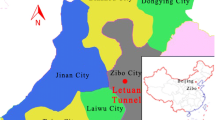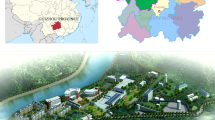Abstract
In the past few decades, an effective support method, i.e., adopting feet-lock pipe combined with steel frame, has been successfully applied to the settlement control in excavation of many weak rock tunnels. However, the mechanism of this combined support has not yet well been understood, and there is a lack of a general approach to explain it. This paper aims to present an analytical approach to explain and evaluate the mechanism of this support. First, an arch model with elastic supports and an elastic foundation beam model are established respectively to model the steel frame and feet-lock pipe. With the force and deformation compatibility conditions between the two members, the formulae for calculating the deflection and internal forces of the feet-lock pipe are derived. The theoretical support effects of the feet-lock pipe are calculated and compared with the existing studies through case studies. Then, with two cases of under symmetrical and unsymmetrical earth pressures being considered, the mechanical behaviors of the feet-lock pipe are analyzed in detail. Finally, a parametric study of an example tunnel is conducted in detail.
Similar content being viewed by others
References
Bierbaumer, A. (1913). Die Dimensionierung des Tunnelmauerwerks, Engelmann, Leipzig.
Chen, J. X. (2011). Tunnel Support Structure Made up of Steel Frame and Shotcrete and Steel Mesh and Feet-lock Rock Bolt, Science Press, Beijing, China (in Chinese).
Chen, L. J., Zhang, Y. L., and Ma, Z. Y. (2015). “Theoretical research on the reasonable installation angle of feet-lock pipe.” Chinese Journal of Rock Mechanics and Engineering, Vol. 34, No. 7, pp. 1334–1344. DOI: 10.1372 2/jcnkijrme.2014.1351 (in Chinese).
Cui, Y., Kishida, K., and Kimura, M. (2010). “Analytical Study on the Control of Ground Subsidence Arising from the Phenomenon of Accompanied Settlement Using Foot Reinforcement Side Pile.” Deep and Underground Excavations, pp. 307–312, DOI: 10.1061/41107(380)42.
Cui, Y., Kishida, K., Kimura, M., and Nonomura, M. (2009). “Control of surface settlement arising from the phenomenon of accompanied settlement using footing reinforcement pile.” Proceedings of ITAAITES World Tunnel Congress, Budapest, Hungary, May.
Deng, G. H., Shao, S. J., Tao, H., and Chen, C. L. (2010). “A study of the effects of locking tremies on the internal force of tunnel support and the deformation of surrounding soil.” China Civil Engineering Journal, Vol. 43, No. 1, pp. 108–113.(in Chinese).
Ding, W. L., Zhao, Y. M., Chu, H. Y., and Su, J. (2008). Technology for a shallow large profile loess tunnel to underpass existing railway, Modern Tunnelling Technology, Vol. 45, No. 6, pp. 76–81. DOI: 10.3969/jissn.1009–6582.2008.06.014 (in Chinese).
Gou, B. and Zhang, Y. B. (2009). “Research on the control technology for large deformation of carbon schist of Xinshuhe tunnel.” Journal of Railway Engineering Society, No. 11, pp. 40–44, DOI: 10.3969/jissn.1006–2106.2009.11.010 (in Chinese).
Han, R. X. (2015). Study on foot-lock bolt force in soft surrounding rock and pre-lining structure bearing capacity, M. S. Dissertation, Beijing Jiaotong University, Beijing (in Chinese).
Hao, Y. Q. and Zhao, D. P. (2012). “Discussion on optimization of construction technology for mountain tunnel portals.” Modern Tunnelling Technology, Vol. 49(S), pp. 47–51 (in Chinese).
Hetenyi, M. (1946) Beams on elastic foundation: Theory with applications in the fields of civil and mechanical engineering. The University of Michigan Press, Ann Arbor.
Huang, B. (2013). Construction techniques for a large-section loess railway tunnel at the dividing line of loess and rock, Modern Tunnelling Technology, Vol. 50, No. 1, pp. 139–142. DOI: 10.3969/jissn.1009–6582.2013.01.023 (in Chinese).
Huang, M. Q. (2009). “Feet-lock bolt mechanism and its application in Xiamen Xiang’an Tunnel.” Railway Construction Technology, No. 7, pp. 86–89, DPI: 10.3969/jissn.1009–4539.20009.07.022 (in Chinese).
JTG D70–2004. Code for Design of Road Tunnel, Beijing (in Chinese).
Kitagawa, T., Goto, M., Isogai, A., Yashiro, K., and Matsunaga, T. (2005). “Analysis on behavior of soft ground tunnels with low earth covering.” Proceedings of tunnel engineering, JSCE, Vol. 15, pp. 203–210.(in Japanese).
Li, H. T. (2014). “The collapse treatment technology in Zhongjia’s No. 2 tunnel.” Railway Engineering, No. 3, pp. 57–59, DOI: 10.3969/jissn.1003–1995.2014.03.18 (in Chinese).
Li, W. P. (2009). “Deformations and their control for highway tunnels traversing soft surrounding rocks.” Modern Tunnelling Technology, Vol. 46, No. 2, pp. 44–49. DOI: 10.3969/jissn.1009–6582.2009.02.006 (in Chinese).
Luo, Y. B. and Chen, J. X. (2013). “Mechanical characteristics and mechanical calculation model of tunnel feet-lock bolt in weak surrounding rock.” Chinese Journal of Geotechnical Engineering, Vol. 35, No. 8, pp. 1519–1525. http://118.145.16.2,17/magsci/article/downPDF?id=18312429 (in Chinese).
Miura, K. (2003). “Design and construction of mountain tunnels in Japan.” Tunnelling and Underground Space Technology, Vol. 18, pp. 115–126. DOI: 10.1016/S0886–7798(03)00038–5.
Terzaghi, K. (1946). Rock Defects and Load on Tunnel Supports, Rock Tunnelling with Steel Support, Proctor, R.V. and White, T.L., Commercial Shearing and Stamping Co., Youngstava, Ohio, USA.
Wu, Y. M., Lü, K. C., and Xu, Y. (2009). “Bearing behaviors of steel foot pipes for tunnels in soft foundation.” Chinese Journal of Geotechnical Engineering, Vol. 31, No. 12, pp. 1825–1832. DOI: 10.3321/jissn:p1000–4548.2009.12.004 (in Chinese).
Xie, J. X. (1964). “Earth pressure on shallow buried tunnel.” China Civil Engineering Journal, Vol. 10, No. 6, pp. 58–70.(in Chinese).
Zeng, C. (2007). “Study on abnormal deformation controlling measures for large cross-section subsea tunnel.” Chinese Journal of Rock Mechanics and Engineering, Vol. 26, No. 11, pp. 2170–2175. DOI: 10.3321/jissn:1000–6915.2007.11.002 (in Chinese).
Zhang, T. (2011). Study on supporting characteristic of tunnel feet-lock bolt (pipe) in weak surrounding rock, M. S. Dissertation, Chang'an University, Xi’an, DOI: 10.7666/dy1947919 (in Chinese).
Zhou, Y. (2007). “Validity analysis of locking anchor pipe and grouting in inverted arch for displacement control of large-section subsea tunnel.” Chinese Journal of Rock Mechanics and Engineering, Vol. 26(Supp. 2), 3830–3834, http://118.145. 16.217/magsci/article/downPDF?id=17911009 (in Chinese).
Author information
Authors and Affiliations
Corresponding author
Rights and permissions
About this article
Cite this article
Chen, LJ., Zhang, YL. & Ma, ZY. Analytical approach for support mechanism of feet-lock pipe combined with steel frame in weak rock tunnels. KSCE J Civ Eng 20, 2965–2980 (2016). https://doi.org/10.1007/s12205-016-0443-3
Received:
Revised:
Accepted:
Published:
Issue Date:
DOI: https://doi.org/10.1007/s12205-016-0443-3




